Red and Painful Eye – Unilateral and Bilateral (Diagnosis and Treatment)
Ears, Eyes, Nose, and Throat
First 5 Minutes
- Critical not to miss sight-threatening conditions such as acute angle-closure glaucoma, endophthalmitis, scleritis, uveitis, iritis, keratitis.
Context
- Conjunctivitis is characterized by inflammation of the conjunctiva and dilatation of the superficial conjunctival blood vessels, resulting in hyperemia (red or pink appearing eye) and edema of the conjunctiva (1).
- For this summary, a patient with a red or pink eye refers to conjunctival and/or scleral redness.
- The differential diagnosis is wide and ranges from benign presentations (subconjunctival hemorrhage) to sight threatening conditions (acute angle-closure glaucoma)
- Table 1 summarizes the key causes for red eye, which can be narrowed down by acuity, presence of pain, and laterality (1,2).
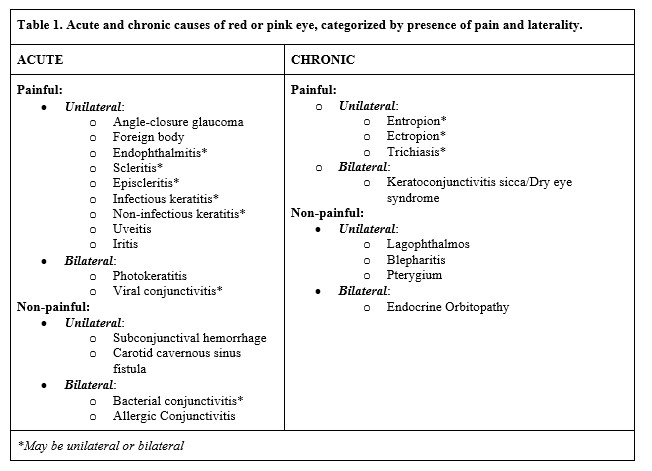
Diagnostic Process
- Narrowing down the diagnosis of red and painful eye involves a thorough history and ophthalmologic examination with the following elements:
- Visual acuity.
- Penlight examination.
- Intraocular pressure.
- Skin and lid examination.
- Slit lamp examination.
- Fluorescein examination.
- The diagnostic process and treatments for vision-threatening and common causes of red and painful eye are outlined below.
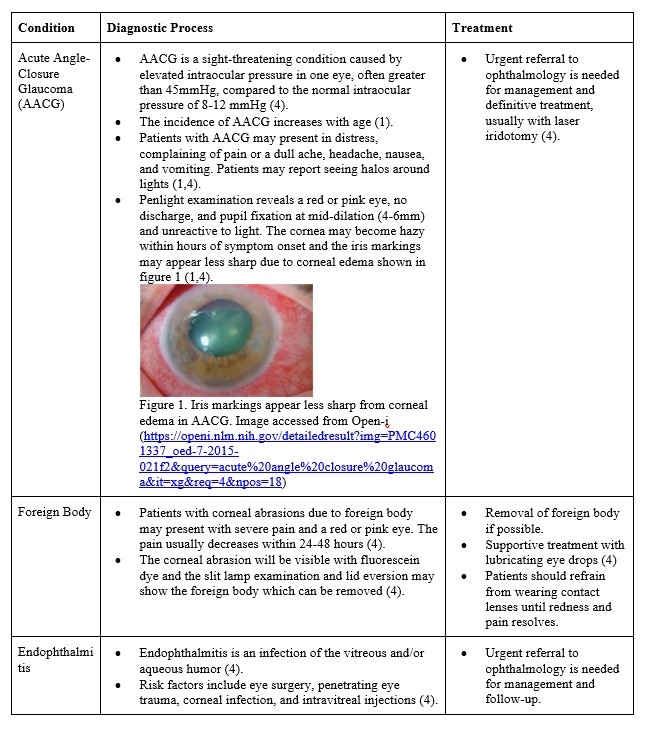
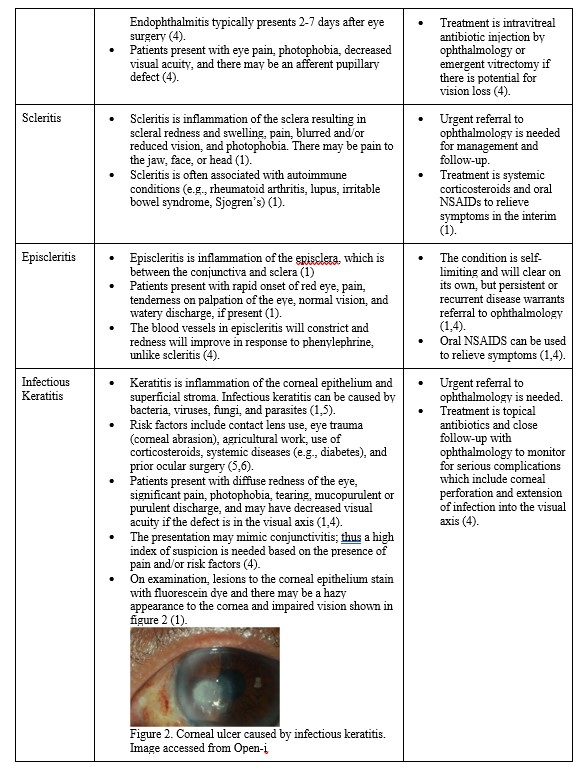
(https://openi.nlm.nih.gov/detailedresult?img=PMC4545699_12886_2015_92_Fig1_HTML&query=&req=4)
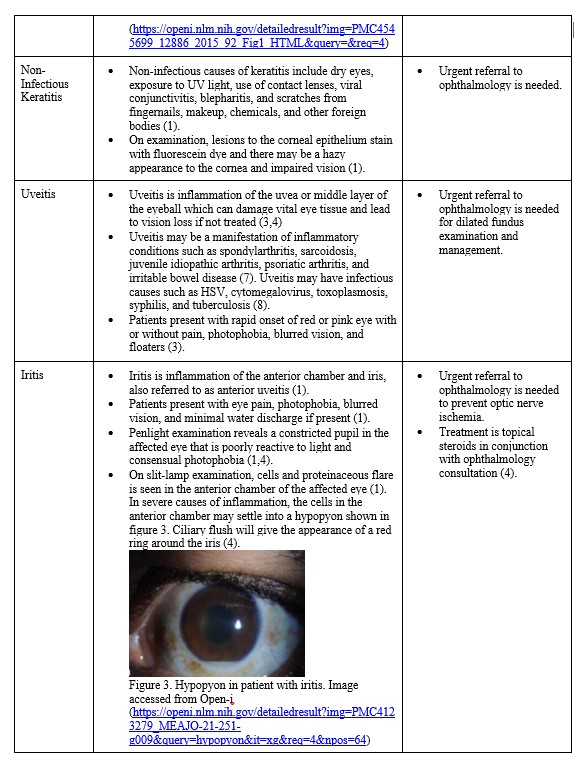
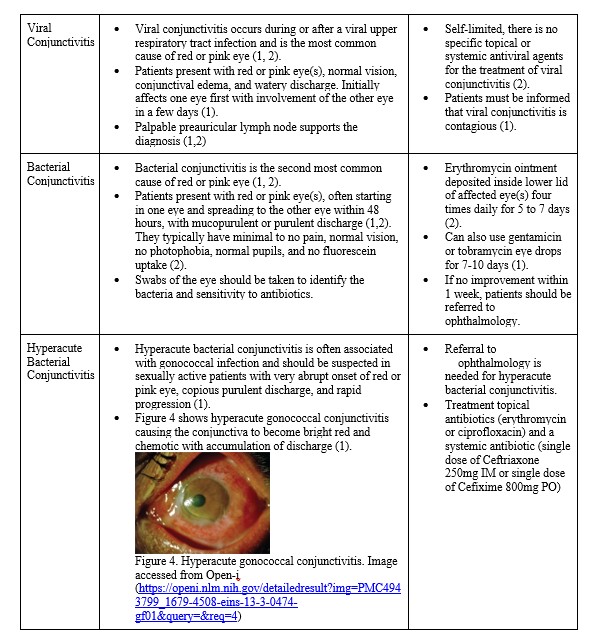
Criteria For Hospital Admission
- Dependent on assessment by ophthalmology.
- For sight-threatening conditions, hospital admission may be warranted if there is inability to adhere to treatment (e.g., medication compliance, social marginalization, housing insecurity, barriers to seeing ophthalmologist, etc.)
Criteria For Transfer To Another Facility
- Dependent on local guidelines. In general, transfer may be considered if:
-
- Patient care requirements exceed hospital capabilities (e.g., cardiac monitoring, intensive care, pediatric or maternal care, etc.).
- Treatment is not available and cannot be delivered to current facility.
- Specialist consultations are required and not available at current facility.
Criteria For Close Observation And/or Consult
- Emergent ophthalmological consultation indicated for patients with suspected acute angle-closure glaucoma, endophthalmitis, scleritis, uveitis, iritis, keratitis.
Quality Of Evidence?

High
We are highly confident that the true effect lies close to that of the estimate of the effect. There is a wide range of studies included in the analyses with no major limitations, there is little variation between studies, and the summary estimate has a narrow confidence interval.
Moderate
We consider that the true effect is likely to be close to the estimate of the effect, but there is a possibility that it is substantially different. There are only a few studies and some have limitations but not major flaws, there are some variations between studies, or the confidence interval of the summary estimate is wide.
Low
When the true effect may be substantially different from the estimate of the effect. The studies have major flaws, there is important variations between studies, of the confidence interval of the summary estimate is very wide.
Justification
- There is a wide range of studies and systematic reviews with small variation between studies. However, some of the studies are as old as 20 years.
Related Information
Reference List
Leibowitz HM. The red eye. N Engl J Med. 2000;343(5):345-351. doi:10.1056/NEJM200008033430507
Azari AA, Barney NP. Conjunctivitis: a systematic review of diagnosis and treatment [published correction appears in JAMA. 2014 Jan 1;311(1):95. Dosage error in article text]. JAMA. 2013;310(16):1721-1729. doi:10.1001/jama.2013.280318
Frings A, Geerling G, Schargus M. Red Eye: A Guide for Non-specialists. Dtsch Arztebl Int. 2017 Apr 28;114(17):302-312. doi: 10.3238/arztebl.2017.0302
Gilani CJ, Yang A, Yonkers M, Boysen-Osborn M. Differentiating Urgent and Emergent Causes of Acute Red Eye for the Emergency Physician. West J Emerg Med. 2017 Apr;18(3):509-517. doi: 10.5811/westjem.2016.12.31798.
Thomas PA, Geraldine P. Infectious keratitis. Curr Opin Infect Dis. 2007;20(2):129–41.
Bourcier T, Thomas F, Borderie V, et al. Bacterial keratitis: predisposing factors, clinical and microbiological review of 300 cases. Br J Ophthalmol. 2003;87(7):834–8.
Rothova A, Buitenhuis HJ, Meenken C et al. Uveitis and systemic disease. Br J Ophthalmol. 1992;76(3):137.
Radosavljevic A, Agarwal M, Chee SP, Zierhut M. Epidemiology of Viral Induced Anterior Uveitis. Ocul Immunol Inflamm. 2022;30(2):297-309. doi:10.1080/09273948.2020.1853177
Relevant Resources
RESOURCE AUTHOR(S)

DISCLAIMER
The purpose of this document is to provide health care professionals with key facts and recommendations for the diagnosis and treatment of patients in the emergency department. This summary was produced by Emergency Care BC (formerly the BC Emergency Medicine Network) and uses the best available knowledge at the time of publication. However, healthcare professionals should continue to use their own judgment and take into consideration context, resources and other relevant factors. Emergency Care BC is not liable for any damages, claims, liabilities, costs or obligations arising from the use of this document including loss or damages arising from any claims made by a third party. Emergency Care BC also assumes no responsibility or liability for changes made to this document without its consent.
Last Updated Dec 29, 2022
Visit our website at https://emergencycarebc.ca
COMMENTS (0)
Add public comment…


POST COMMENT
We welcome your contribution! If you are a member, log in here. If not, you can still submit a comment but we just need some information.